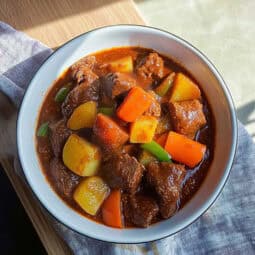
Filipino Beef Mechado (Mechadong Baka)
Beef Mechado (Mechadong Baka) is a beloved Filipino beef stew that showcases the perfect marriage of Spanish influence and Filipino culinary innovation. This comprehensive guide will teach you how to make this hearty dish like a true Filipino home cook.What is Mechado? Mechado comes from the Spanish word "mecha" meaning "wick." The name refers to the traditional technique of threading pork fat through beef, similar to inserting a wick into a candle. In Filipino cuisine, it has evolved into a rich tomato-based stew that's perfect for family gatherings and special occasions.
Equipment
- Heavy-bottom pot or Dutch oven
- Sharp knife
- Cutting board
- Measuring cups and spoons
- Wooden spoon
- Tongs
Ingredients
For the Meat
- 2 pounds 1 kg beef chuck roast or top round, cut into 2-inch cubes (karneng baka)
- ¼ pound 113g pork back fat, cut into thin strips (taba ng baboy) [optional]
For the Marinade
- ¼ cup calamansi juice katas ng kalamansi or lemon juice
- ¼ cup soy sauce toyo
- 1 teaspoon ground black pepper paminta
For the Stew
- ¼ cup cooking oil mantika
- 2 medium potatoes peeled and quartered (patatas)
- 2 medium carrots peeled and cut into chunks (karot)
- 1 large onion diced (sibuyas)
- 6 cloves garlic minced (bawang)
- 1 cup tomato sauce sarsa ng kamatis
- 3 cups beef broth or water sabaw ng baka
- 2 bay leaves dahon ng laurel
- 1 red bell pepper chunks (pulang bell pepper)
- 1 green bell pepper chunks (berdeng bell pepper)
- Salt to taste asin
Instructions
- Remove the beef from the refrigerator 30 minutes before cooking and pat dry with paper towels. Slice the beef chuck roast into uniform 2-inch cubes (karneng baka na hiniwa ng parisukat). If using pork fat (taba ng baboy), cut it into thin strips and insert these into the beef pieces using a small knife, making small pockets in the meat for the fat.
- Prepare your marinade by combining calamansi juice (katas ng kalamansi) and soy sauce (toyo) in a bowl. Add the beef pieces and marinate for 30 minutes at room temperature. While waiting, peel and quarter your potatoes (patatas) and carrots (karot), dice the onion (sibuyas), and mince the garlic (bawang).
- Heat your Dutch oven or heavy-bottomed pot (makapal na kaldero) to medium-high heat (375°F/190°C). Add cooking oil (mantika). Once the oil is hot, brown the potatoes and carrots until they develop a golden crust, about 5 minutes per side. Remove the vegetables and set aside.
- Using the same pot, maintain the heat at 350°F (175°C). Sauté the minced garlic until fragrant and lightly golden (hanggang mabango), about 1-2 minutes. Add the diced onions and cook until they become translucent (hanggang malabo), about 3-4 minutes.
- Remove the beef from the marinade, but save the liquid. Brown the beef pieces in batches in the pot, ensuring each piece has enough space to develop a good sear. This should take about 5-7 minutes per batch. Avoid overcrowding the pot (huwag masyadong punuin ang kawali) as this will cause the meat to steam rather than brown.
- Once all the beef is browned, return all meat to the pot and add the reserved marinade. Let it reduce slightly, scraping the bottom of the pot to release any browned bits (tutungin). Pour in the tomato sauce (sarsa ng kamatis) and beef broth (sabaw ng baka). Add the bay leaves (dahon ng laurel).
- Reduce the heat to 300°F (150°C) and bring to a gentle simmer. Cover and cook for about 1.5 hours, or until the beef starts to become tender. Check occasionally and add more broth if needed to keep the meat partially submerged.
- When the beef is nearly tender (internal temperature around 190°F/88°C), add back the browned potatoes and carrots. Continue cooking for about 20 minutes until the vegetables are tender but not mushy (malambot pero hindi masyadong luto).
- Add the bell peppers (paminta) in the last 5 minutes of cooking. The beef should be fork-tender at this point, reaching an internal temperature of 200-205°F (93-96°C). Season with salt (asin) to taste.
- Turn off the heat and let the mechado rest for 15 minutes before serving. This resting period allows the meat to become even more tender and the flavors to settle (pahupain). The sauce should be rich and slightly thick, coating the back of a spoon.
- Serve hot over steamed white rice (mainit na kanin). You can offer additional calamansi halves on the side for those who want extra tartness, and some pickled papaya (atchara) as a traditional accompaniment.
- For storage (pag-iimbak), let the mechado cool completely before transferring to an airtight container. It will keep in the refrigerator for up to 4 days. When reheating, warm gently on the stovetop over low heat (275°F/135°C), adding a splash of beef broth if the sauce has thickened too much.
- Remember, mechado often tastes even better the next day as the flavors continue to develop overnight. This makes it an excellent make-ahead dish for special occasions.
Tips from Lola's Kitchen
- Choose beef with visible marbling for better flavor
- "Magpatulo ng konting mantika" - Let a little oil drip: Don't rush the searing process
- "Pakuluan muna ang patatas" - Parboil potatoes first to ensure even cooking
- Use banana ketchup for a uniquely Filipino twist
- Let the stew rest for 15 minutes before serving for better flavor distribution
Nutrition
Calories: 450kcalCarbohydrates: 6gProtein: 40gFat: 50gSaturated Fat: 1gPolyunsaturated Fat: 3gMonounsaturated Fat: 6gTrans Fat: 0.04gSodium: 736mgPotassium: 235mgFiber: 2gSugar: 3gVitamin A: 875IUVitamin C: 45mgCalcium: 18mgIron: 1mg
Tried this recipe?Let us know how it was!